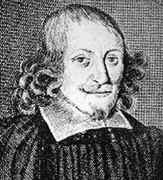Person: Picard, Jean

Jean Picard was a French astronomer who increased the accuracy of astronomical observations.
Mathematical Profile (Excerpt):
- Jean studied at the Jesuit College at La Flèche.
- It must remain a matter of conjecture as to how far Picard's studies were interrupted by the civil unrest which was so prevalent in that part of France in the 1630s and 1640s; and the Jesuit College itself was a highly volatile institution as the breakdown of social order affected the conduct of the students too.
- Picard left the Jesuit College at La Flèche around 1644 and went to live in Paris.
- Pierre Gassendi was appointed as Professor of Mathematics at the Collège Royale in 1645 and it is likely that Picard attended his lectures there.
- At any rate Picard became a disciple of Gassendi around this time and helped him with observations of a solar eclipse on 21 August 1645.
- There are a number of puzzles which, despite Olmsted's research, still remain about Picard's life and one should be mentioned at this point.
- In 1655 Picard became professor of astronomy at the Collège de France in Paris, following the death of Gassendi in October of that year, but not on the strength of any published work for none had appeared.
- Picard became a member of the Académie Royale des Sciences in 1666, just after its foundation, and from this time on devoted himself to working for the Académie.
- In his later writings he referred to himself as the 'Abbé of Rillé.' Certainly there is a town of Rillé is in Anjou, not that far from La Flèche, where Picard was born, and it has been assumed that this was where he had worked as a priest and prior.
- This would also have given Picard an income and explain other puzzles about Picard's life.
- Picard devised a micrometer to measure the diameters of celestial objects such as the Sun, Moon and planets.
- Jean Picard was a shy and modest abbot who took their innovations and applied them systematically to astronomy, geodesy, and levelling.
- Picard's passion was precision, and in this area he was unsurpassed; not even John Flamsteed could match his accuracy.
- Picard was a tireless worker, often away in the provinces or abroad on some important project while others were in the limelight in Paris.
- Picard greatly increased the accuracy of measurements of the Earth, using Snell's method of triangulation.
- The use of these techniques meant that Picard was one of the first to apply scientific methods to the making of maps.
- Picard was honoured for these contributions with a pyramid erected at Juvisy-sur-Orge, one end of his baseline, in 1740.
- In 1671 Picard went to Tycho Brahe's observatory at Hven Island in Sweden so that its location could be determined accurately and so Tycho's observations could be directly compared with others.
- There over a period of several months, working with Ole Rømer, he observed about 140 eclipses of Jupiter's moon Io, while Jean-Dominique Cassini in Paris carried out the same observations.
- In 1673 Picard moved to the Paris Observatory where he collaborated with Jean Richer, Jean-Dominique Cassini and, slightly later, with La Hire.
- Rømer also went to the Paris Observatory following the visit to Hven Island and, with Picard, continued to observe the moons of Jupiter.
- It was from the data that Picard and Rømer collected that Rømer was able to calculate the speed of light by noting the discrepancies in the timings of the eclipses due to the time light takes to travel to the Earth.
- We should also mention another significant discovery by Picard, namely his discovery of barometric light in 1675.
- Picard was also involved with the measurement of the length of the second pendulum.
- Also at the Paris Observatory, Picard was involved with measuring the parallax of Mars.
- The value Picard, working with Jean-Dominique Cassini, and Jean Richer, deduced for the distance from the Earth to the sun underestimates the true value by 8.5%.
- Also at the Paris Observatory, Picard tried to measure the parallax of nearby stars and so verify the fact that the Earth orbits the sun.
- Among Picard's other skills were hydraulics, a topic on which he wrote but also one where he put his skills into practice.
- Prodigious engineering efforts went into the solutions to this problem, and Picard's new levelling instruments with telescopic sights helped determine routes and avoided costly errors.
- Picard corresponded with many of the leading scientists of his time including Bartholin, Hevelius, Hudde and Huygens.
Born 21 July 1620, La Flèche, France. Died 12 October 1682, Paris, France.
View full biography at MacTutor
Tags relevant for this person:
Geography
Thank you to the contributors under CC BY-SA 4.0! 

- Github:
-

- non-Github:
- @J-J-O'Connor
- @E-F-Robertson
References
Adapted from other CC BY-SA 4.0 Sources:
- O’Connor, John J; Robertson, Edmund F: MacTutor History of Mathematics Archive
